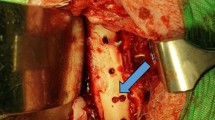Abstract
Objective
The rate of postoperative infections is approximately 1% in spine surgery. However, when metal implants are used, postoperative infection rates significantly increase and were reported between 2.1 and 8.5%. This study aim to set up an infection model in the rat spine with a metal implant.
Materials and methods
Forty white male Sprague Dawley rats were randomly divided in four groups. In all rats, under operation microscope, a 3 mm titanium microscrew was implanted in the thoracolumbar area (T10-L1) after laminar decortication. In Group I (control group), sterile isotonic solution and in other three groups, different concentrations of Staphylococcus aureus [Group II: (102), Group III: (103), Group IV: (106)] were squirted on the decorticated lamina site. All animals were sacrificed after 2 weeks, and then blood cultures and cultures from fascia, muscle and bone were obtained. Bacterial number in each tissue was measured as colony-forming unit per gram tissue. Titanium microscrews were placed in 0.5 ml tryptic soy broth and vortexed than plated on trypticase soy agar to determine bacterial growth. Two animals from each group were subjected to histological examination.
Results
Blood cultures obtained by intra-atrial puncture after 2 weeks were negative in all groups indicating no systemical infection developed. Bacterial cultures were negative in all specimens of Group I (control group). A significant osseous infection was confirmed in Groups II, III and IV. Comparison of bacterial counts in bone cultures showed no significant difference between Group III (103 CFU/10 μl) and Group IV (106 CFU/10 μl) (P > 0.05), while both groups had significantly higher counts than Group II (102 CFU/10 μl) (P > 0.05). Microscopic findings of supurrative inflammation were present only in Group IV (106 CFU/10 μl).
Conclusions
This study shows that inoculation of S. aureus in 106 CFU/10 μl concentration at the decorticated lamina after implantation of a titanium screw in rat spine is a reproducible model for spinal infection and can be used for the animal model of prophylaxis and treatment and of postoperative infection.



Similar content being viewed by others
References
Abbey DM, Turner DM, Warson JS, Wirt TC, Scalley RD (1995) Treatment of postoperative wound infections following spinal fusion with instrumentation. J Spinal Disord 8:278–283
Arens S, Schlegel U, Printzen G, Ziegler WJ, Perren SM, Hansis M (1996) Influence of materials for fixation implants on local infection. An experimental study of steel versus DCP in rabbits. J Bone Joint Surg (Br) 78:647–651
Beiner JM, Grauer J, Kwon BK, Vaccaro AR (2003) Postoperative wound infections of the spine. Neurosurg Focus 15(3):E14
Burgi E, Sydler T, Ohlerth S, Corboz L, Nietlispach G (2001) Purulent osteomyelitis in fattening pigs. Schweiz Arch Tierheilkd 143:93–98
Calderone RR, Garland DE, Capen DA, Oster H (1996) Cost of medical care for postoperative spinal infections. Orthop Clin North Am 27:171–182
Christensen GD, Simpson WA, Bisno AL, Beachey EH (1982) Adherence of slime-producing strains of Staphylococcus epidermidis to smooth surfaces. Infect Immun 37:318–326
Dimar JR, Ante WA, Zhang YP, Glassman SD (1996) The effects of nonsteroidal anti-inflammatory drugs on posterior spinal fusion in the rat. Spine 21:1870–1876
Fang A, Hu SS, Endres N, Bradford DS (2005) Risk factors for infection after spinal surgery. Spine 30(12):1460–1465
Gristina AG (1987) Biomaterials centered infection. Microbial adhesion versus tissue integration. Science 237:1588–1595
Gristina AG, Costerton JW (1984) Bacterial adherence and the glycocalyx and their role in musculoskeletal infection. Orthop Clin North Am 15:517–535
Gristina AG, Costerton JW (1985) Bacterial adherence to biomaterials and tissue. The significance of its role in clinical sepsis. J Bone Joint Surg (Am) 67:264–273
Guiboux JP, Ahlgren B, Patti JE, Bernhard M, Zervos M, Herkowitz HN (1998) The role of prophylactic antibiotics in spinal instrumentation. A rabbit model. Spine 23:653–656
Korkusuz F, Uchida A, Shinto Y, Araki N, Inoue K, Ono K (1993) Experimental implant-related osteomyelitis treated by antibiotic-calcium hydroxyapatite ceramic composites. J Bone Joint Surg Br 75:111–114
Levi AD, Dickman CA, Sonntag VK (1997) Management of postoperative infections after spinal instrumentation. J Neurosurg 86:975–980
Lonstein JE (1989) Management of post-operative spine infections. In: Gustillo RB (ed) Current concepts in the management of musculoskeletal infections. WB Saunders, Philadelphia pp 243–249
Lucke M, Schmidmaier G, Sadoni S, Wildemann B, Schiller R, Stemberger A, Hass NP, Raschke M (2003) Gentamicin coating of metallic implants reduces implant-related osteomyelitis in rats. Bone 32:521–531
Lucke M, Schmidmaier G, Sadoni S, Wildemann B, Schiller R, Stemberger A, Hass NP, Raschke M (2003) A new model of implant-releated osteomyelitis in rats. J Biomed Mater Res Part B:Appl Biomater 67:593–602
Mehbod AA, Ogilvie JW, Pinto MR, Schwender JD, Transfeldt EE, Wood KB, Le Huec JC, Dressel T (2005) Postoperative deep wound infections in adults after spinal fusion. J Spinal Disord Tech 18:14–17
Picada R, Winter RB, Lonstein JE, Denis F, Pinto MR, Smith MD, Perra JH (2000) Postoperative deep wound infection in adults after posterior lumbosacral spine fusion with instrumentation: incidence and management. J Spinal Disord 13:42–45
Poelstra KA, Barekzi NA, Gainger DW, Gristina AG, Schuler TC (2000) A novel spinal implant infection model in rabbits. Spine 25:406–410
Rissing JP, Buxton TB, Weinstein RS, Shockley RK (1985) Model of experimental chronic osteomyelitis in rats. Infect Immun 47:581–586
Shirtliff ME, Calhoun JH, Mader JT (2002) Experimental osteomyelitis treatment with antibiotic-impregnated hydroxyapatite. Clin Orthop Relat Res 239–247
Smeltzer MS, Thomas JR, Hickmon SG, Skinner RA, Nelson CL, Griffith D, Parr TR, Evans RP (1997) Characterization of a rabbit model of staphylococcal osteomyelitis. J Orthop Res 15:414–421
Spagnolo N, Greco F, Rossi A, Ciolli L, Teti A, Posteraro P (1993) Chronic staphylococcal osteomyelitis: a new experimental rat model. Infect Immun 61:5225–5230
Weinstein MA, McCabe JP, Cammisa FB Jr (2000) Postoperative spinal wound infection: a review of 2,391 consecutive index procedures. J Spinal Disord 13(5):422–426
Author information
Authors and Affiliations
Corresponding author
Rights and permissions
About this article
Cite this article
Ofluoglu, E.A., Zileli, M., Aydin, D. et al. Implant-related infection model in rat spine. Arch Orthop Trauma Surg 127, 391–396 (2007). https://doi.org/10.1007/s00402-007-0365-0
Received:
Published:
Issue Date:
DOI: https://doi.org/10.1007/s00402-007-0365-0




